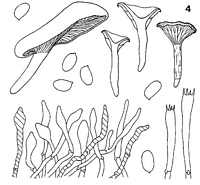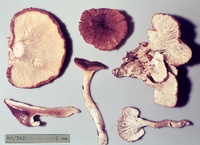|
 Hygrophoropsis umbriceps Hygrophoropsis umbriceps
SynonymsCantharellus umbriceps
BiostatusPresent in region - Indigenous. Endemic
Images (click to enlarge)
Caption: H. umbriceps: spores | 
Caption: Fig. 4. Hygrophoropsis umbriceps (Cooke) McNabb (ZT 68/342): carpophores, spores, basidia, cuticle | 
Caption: ZT68-342
Owner: E. Horak: © Creative Commons Attribution-Noncommercial 3.0 New Zealand |
Article: McNabb, R.F.R. (1969). The Paxillaceae of New Zealand. New Zealand Journal of Botany 7(4): 349-362 (http://www.rsnz.org/publish/abstracts.php).
Description: PILEUS: convex, centrally depressed at maturity, 2.5 cm diam., glabrous, umber;
cuticle a trichodermium, composed of erect, thin-walled, filamentous hyphae
with clamp connections, terminal cells to 14 µm. diam., contents dark brown;
margins involute. LAMELLAE: moderately crowded, deeply decurrent, dichotomously
branched, orange. STIPE: 5 cm long, tapering apically, 12 mm diam. basally,
solid, dry, sordid white with yellowish and brownish tints.
SPORES: spore print unknown; spores hyaline or faintly
yellowish in KOH, pseudoamyloid, broadly elliptical, short-cylindrical with
obtuse ends, or occasionally subreniform, minutely apiculate, germ pore absent,
6.5-8.2 X 3-4.3 m., slightly thick-walled, smooth. HYMENIUM and HYMENOPHORAL
TRAMA: details obscure. CONTEXT OF PILEUS: tinted orange.
Habitat: HABITAT:
Solitary on ground.
Notes: The above description is adapted from that of Cooke, with the addition of a
few microscopical characters. The major difference between the two descriptions centres on the spores. In the protologue they were described
as " . . . small, subglobose" and in Massee's (1898) description as
". . . globose, 4 µm. diameter." The type specimen is heavily contaminated
with globose spores 3-4 µm. in diameter and it is likely that these were confused
with the true spores of this species. Corner's (1966) description of the type
is similar to that given above, although he retained the species in Cantharellus.
The pseudoamyloid spore reaction in Melzer's solution which is characteristic
of Hygrophoropsis was not mentioned by Corner.
There is some doubt as to the geographical position of the type locality. Hughes
(1966) concluded that "Maungaroa" was an error for Mangaroa, a locality
near Wellington.
Hygrophoropsis umbriceps is readily distinguishable from H. coacta by
the darker coloured pileus, presence of a trichodermium, and the pallid stipe.
Article: Horak, E. (1980) [1979]. Paxilloid Agaricales in Australasia. Sydowia 32: 154-166.
Description: Pileus -65 mm, centre depressed, umbilicate or funnel-shaped from the beginning, margin strongly inrolled; dark brown to soot brown; velutinous to felty all over, surface cracking in aged specimens dry, margin not striate, veil remnants absent. Lamellae moderately crowded, decurrent, 4 dichotomously forked; whitish to cream becoming pale argillaceous with age; edge rounded, concolorous. Stipe –50 x -6 mm, cylindric or tapering towards base, occasionally fusoid, central; pale brown, villous base white; glabrous, dry, solid, cespitose or single in groups. Context pale brown. Odour and taste not distinctive. Chemical reactions unknown. Spore print white.
Spores 5.5 - 7.5(-8) x 3 - 4.5 µm, hyaline, membrane thinwalled, smooth, strongly dextrinoid. Basidia 30 – 45 x 5 - 7 µm, 4-spored. Cystidia absent. Cuticle a palisade of clavate to fusoid cells 35 – 80 x 5—15 µ), membrane thin-walled, not gelatinized, with dark brown vacuolar and plasmatic pigment. Clamp connections present.
Habitat: On soil among litter under Nothofagus spp. — New Zealand.
Notes: McNabb’s description of this characteristic species of Hygrophoropsis was drawn from the rather short original diagnosis supplemented by microscopic data observed on the poorly preserved type material (compare also Corner 1966: 75).
Under these circumstances my description of H. umbriceps (taken from fresh and well preserved fruitingbodies) is presented:
Article: McNabb, R.F.R. (1971). Some new and revised taxa of New Zealand Basidiomycetes (Fungi). New Zealand Journal of Botany 9(2): 355-370 (http://www.rsnz.org/publish/abstracts.php).
Notes: belongs in Hygrophoropsis (Paxillaceae) and was transferred to this genus by McNabb (1969).
Article: Massee, G.E. (1899) [1898]. The fungus flora of New Zealand. Transactions and Proceedings of the New Zealand Institute 31: 282–349 Wellington:.
Description: Pileus fleshy, soft, subglobose, then expanding, then depressed, margin incurved, glabrous,
umber, about 3 cm. diameter ; gills very narrow, thick, forked, not crowded, dingy-orange;
stem about 4 cm. long and 1 cm. thick at the slightly swollen base, solid, white with a tinge of
yellow; spores globose, 4 µ, diameter.
Habitat: On the ground.
Distribution: Maungaroa, New Zealand.
Notes: As the species was founded upon the examination of a single specimen, accompanied by a
coloured drawing, it is probable that the size and some minor details given above may require
modification.
Article: Cooke, M.C. (1879). New Zealand fungi. Grevillea 8(46): 54-68.
Description: Pileus about an inch broad; stem two inches long, half an inch thick at the base, attenuated upwards; flesh tinged with orange; spores small, subglobose.
Article: Horak, E. (1971). A contribution towards the revision of the Agaricales (Fungi) from New Zealand. New Zealand Journal of Botany 9(3): 403-462 (http://www.rsnz.org/publish/abstracts.php).
Notes: This material (BERGGREN 138) undoubtedly belongs to Hygrophoropsis. The
species was transferred to this genus by McNabb (1969).
|